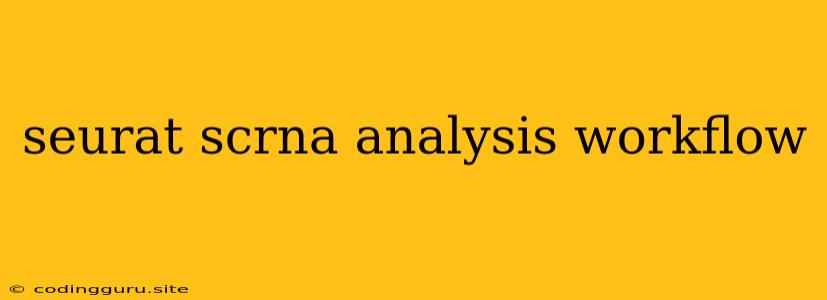Unraveling Cellular Secrets: A Guide to Seurat scRNA-seq Analysis Workflow
Single-cell RNA sequencing (scRNA-seq) has revolutionized our understanding of cellular heterogeneity, allowing researchers to delve into the intricate molecular landscape of complex tissues and organs. However, the sheer volume of data generated by scRNA-seq experiments necessitates robust analytical tools to extract meaningful insights. Enter Seurat, a powerful open-source R package designed for single-cell analysis, which offers a comprehensive workflow for exploring, clustering, and interpreting scRNA-seq data.
This guide provides a step-by-step breakdown of the Seurat scRNA-seq analysis workflow, highlighting key considerations and best practices for achieving accurate and insightful results.
1. Data Import and Preprocessing:
The journey begins with importing your scRNA-seq data into Seurat. This involves creating a Seurat object, which serves as the central data structure throughout the analysis. The first step in data preprocessing involves quality control, aiming to identify and remove low-quality cells or genes that can skew downstream analyses. This typically involves assessing metrics like:
- Number of genes detected: This metric helps identify cells with low gene counts, possibly due to poor cell capture or sequencing quality.
- Number of unique molecular identifiers (UMI): UMI counts reflect the total number of transcripts detected per cell.
- Percentage of mitochondrial genes: High mitochondrial gene expression can indicate cell stress or damage, potentially biasing the analysis.
Based on these metrics, you can filter out cells that fall outside reasonable thresholds, ensuring that your analysis focuses on high-quality cells.
2. Normalization and Feature Selection:
Normalization is crucial for accounting for differences in library size and sequencing depth across cells. Seurat offers various normalization methods, with the most common being log-normalization. This approach transforms gene expression values into a common scale, facilitating meaningful comparisons between cells.
Next, you'll want to select a subset of highly variable genes (HVGs). These genes exhibit significant variation across cells and are often more informative for downstream analysis. Seurat provides tools for identifying HVGs based on the variance of their expression, aiding in the identification of genes that drive cellular heterogeneity.
3. Dimensionality Reduction and Clustering:
The high dimensionality of scRNA-seq data presents a challenge for visualization and clustering. Seurat employs dimensionality reduction techniques like principal component analysis (PCA) and t-distributed stochastic neighbor embedding (t-SNE) to project the data onto a lower-dimensional space while preserving key biological relationships.
Once the data has been reduced, you can perform clustering. Seurat leverages algorithms like k-nearest neighbors (KNN) and graph-based clustering to group cells with similar gene expression profiles. Clustering enables the identification of distinct cell populations within your data.
4. Cell Identity Annotation:
With clusters defined, the next step involves assigning meaningful identities to each cluster. This can be achieved through a combination of:
- Marker gene analysis: Identifying genes that are differentially expressed between clusters can provide insights into the specific biological functions of each cell population.
- Reference data integration: If you have prior knowledge about cell types in your tissue or system, you can integrate reference datasets to aid in annotation.
- External validation: Comparing your results to established marker gene databases or literature can help validate your annotations.
5. Trajectory Analysis:
For exploring developmental processes or lineage relationships, Seurat offers tools for trajectory analysis. This approach aims to reconstruct the developmental path of cells by identifying the order in which they transition between different states. Techniques like pseudotime analysis and monocle allow you to visualize and interpret the dynamics of cellular differentiation.
6. Differential Gene Expression Analysis:
To delve deeper into the molecular differences between cell clusters, Seurat provides powerful differential gene expression (DGE) analysis capabilities. DGE analysis identifies genes that are significantly upregulated or downregulated in specific clusters, providing insights into the biological processes driving cell heterogeneity.
7. Visualization and Interpretation:
Finally, Seurat offers various visualization tools to help you interpret your results. These include:
- Heatmaps: Visualizing the expression of marker genes across cell clusters.
- Scatter plots: Representing cell-cell relationships in low-dimensional space.
- Violin plots: Comparing the expression of genes between cell clusters.
- Feature plots: Mapping gene expression onto the low-dimensional representation of the data.
Conclusion
The Seurat scRNA-seq analysis workflow provides a comprehensive and robust framework for exploring the intricate landscape of cellular heterogeneity. By following these steps, you can gain valuable insights into the molecular mechanisms underlying cell function, differentiation, and disease. Remember, as with any bioinformatic analysis, it is essential to carefully consider the limitations and assumptions of each step to ensure accurate and interpretable results.
